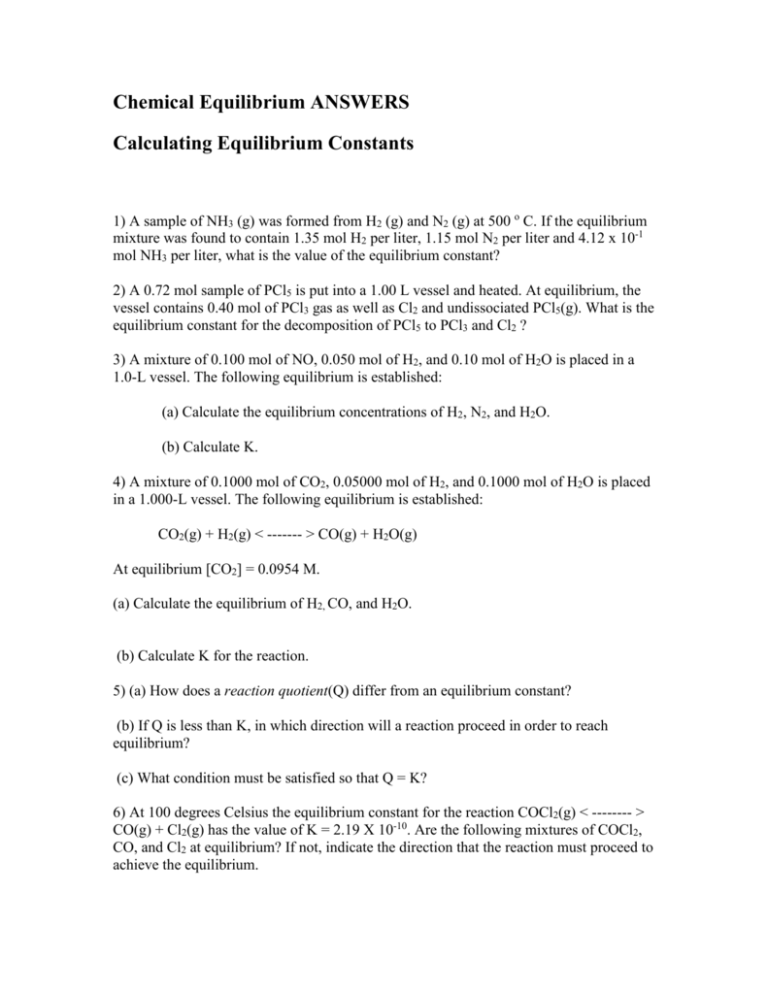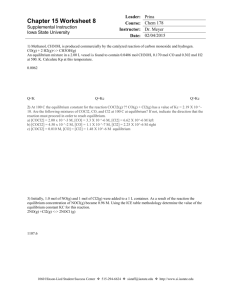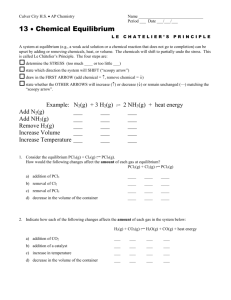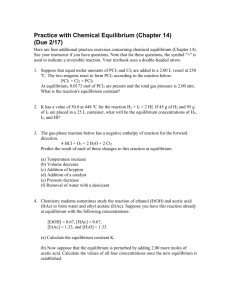Equilibrium WS - mvhs
advertisement

Chemical Equilibrium ANSWERS Calculating Equilibrium Constants 1) A sample of NH3 (g) was formed from H2 (g) and N2 (g) at 500 o C. If the equilibrium mixture was found to contain 1.35 mol H2 per liter, 1.15 mol N2 per liter and 4.12 x 10-1 mol NH3 per liter, what is the value of the equilibrium constant? 2) A 0.72 mol sample of PCl5 is put into a 1.00 L vessel and heated. At equilibrium, the vessel contains 0.40 mol of PCl3 gas as well as Cl2 and undissociated PCl5(g). What is the equilibrium constant for the decomposition of PCl5 to PCl3 and Cl2 ? 3) A mixture of 0.100 mol of NO, 0.050 mol of H2, and 0.10 mol of H2O is placed in a 1.0-L vessel. The following equilibrium is established: (a) Calculate the equilibrium concentrations of H2, N2, and H2O. (b) Calculate K. 4) A mixture of 0.1000 mol of CO2, 0.05000 mol of H2, and 0.1000 mol of H2O is placed in a 1.000-L vessel. The following equilibrium is established: CO2(g) + H2(g) < ------- > CO(g) + H2O(g) At equilibrium [CO2] = 0.0954 M. (a) Calculate the equilibrium of H2, CO, and H2O. (b) Calculate K for the reaction. 5) (a) How does a reaction quotient(Q) differ from an equilibrium constant? (b) If Q is less than K, in which direction will a reaction proceed in order to reach equilibrium? (c) What condition must be satisfied so that Q = K? 6) At 100 degrees Celsius the equilibrium constant for the reaction COCl2(g) < -------- > CO(g) + Cl2(g) has the value of K = 2.19 X 10-10. Are the following mixtures of COCl2, CO, and Cl2 at equilibrium? If not, indicate the direction that the reaction must proceed to achieve the equilibrium. (a) [COCl2] = 5.00 X 10-2 M, [CO] = 3.31 X 10-6 M, [Cl2] = 3.31 X 10-6 M; (b) [COCl2] = 3.50 X 10-3 M, [CO] = 1.11 X 10-5 M, [Cl2] = 3.25 X 10-6 M; (c) [COCl2] = 1.45 M, [CO] = [Cl2] = 1.56 X 10-6 M. 7) At 100 degrees Celsius, K = 0.078 for the following reaction: SO2Cl2(g) < --------- > SO2(g) + Cl2(g) In the equilibrium mixture of the three gases the concentrations of SO2Cl2 and SO2 are 0.136 M and 0.072 M, respectively. What is [Cl2] in the equilibrium mixture? 8) At 2000 degrees Celsius the equilibrium concentration for the reaction 2NO(g) < ------- > N2(g) + O2(g) is K = 2.4 X 103. If the initial concentration of NO is 0.500 M, what is the equilibrium concentration of NO, N2, and O2. Review for Quiz on Chemical Equilibrium 1. For the reaction N2(g) + 3Cl2(g) 2NCl3(g) An analysis of an equilibrium mixture is performed. It is found that [NCl3(g)]= 1.9x10-1 M, [N2(g)]= 1.4x10-3 M, and [Cl2(g)]=4.3x10-4 M. Calculate K for the reaction. Ans: 3.2 X 1011 2. For the reaction CaCO3 (s) CaO(s) + CO2(g) It is found that at equilibrium [CO2]= 2.1x10-3 M at a particular temperature. Calculate K for the reaction at this temperature. Ans: 2.1X 10-3 3. For the reaction N2O4 (g)2NO2(g) The equilibrium constant K has the value of 8.1 x 10-3 at a particular temperature. If the concentration of NO2(g) is found to be 0.0021 M in the equilibrium system, what is the concentration of N2O4(g) under these conditions? Ans: 5.4 X10-4 M 4. Why does increasing the temperature favor an increase in the speed of a reaction? 5. Suppose K= 4.5x10-3 at a certain temperature for the reaction PCl5(g) PCl3(g)+ Cl2 (g) If it is found that the concentration of PCl5 is twice the concentration of PCl3, what must be the concentration of Cl2 under these conditions? ANS: 9.0 X10-3 M 6. Discuss in general terms the effect on the net amount of product when an additional amount of one of the reactants is added to an equilibrium system. Does the value of the equilibrium constant change in this situation? Ans: more product is produced; equilibrium constant does not change (only changes with temperature) 7. What is the effect on the equilibrium position if an endothermic reaction is performed at a higher temperature? Does the net amount of product increase or decrease? Does the value of the equilibrium constant change if the temperature is increased? Ans: net amount of product increase; equilibrium constant changes 8. Suppose the reaction system CH4(g) + 2O2(g) CO2(g) + 2H2O(l) Has already reached equilibrium. Predict the effect of each of the following changes on the position of the equilibrium. Tell whether the equilibrium will shift to the right, will shift to the left, or will not be affected. a. Any liquid water present is removed from the system Ans. No change b. CO2 is added to the system by dropping a chunk of dry ice into the reaction vessel Ans. shifts left c. The reaction is performed in a metal cylinder fitted with a piston, and the piston is compressed to decrease total volume of the system Ans. shifts right d. Additional O2(g) is added to the system from a cylinder of pure O2 Ans. shifts right



![CHEM 1520 SI MON, TUES, & WEDNES 1.Calculate [H3O+] in a](http://s3.studylib.net/store/data/007346334_1-b78d73402f58153c92290299886ff084-300x300.png)



